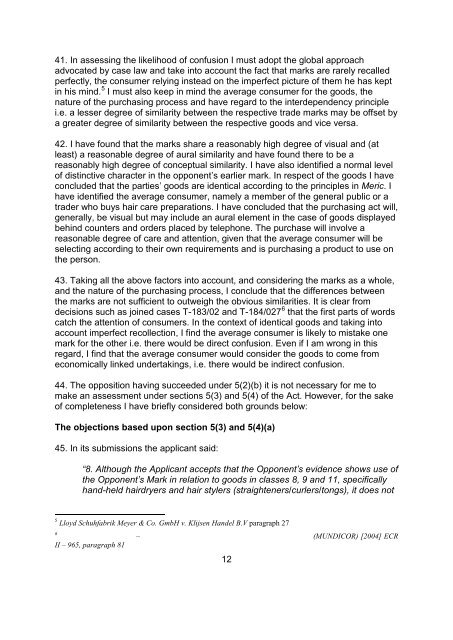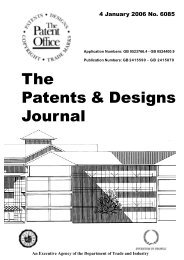Trade Mark Inter Partes Decision (O/189/12)
Trade Mark Inter Partes Decision (O/189/12)
Trade Mark Inter Partes Decision (O/189/12)
You also want an ePaper? Increase the reach of your titles
YUMPU automatically turns print PDFs into web optimized ePapers that Google loves.
41. In assessing the likelihood of confusion I must adopt the global approach<br />
advocated by case law and take into account the fact that marks are rarely recalled<br />
perfectly, the consumer relying instead on the imperfect picture of them he has kept<br />
in his mind. 5<br />
I must also keep in mind the average consumer for the goods, the<br />
nature of the purchasing process and have regard to the interdependency principle<br />
i.e. a lesser degree of similarity between the respective trade marks may be offset by<br />
a greater degree of similarity between the respective goods and vice versa.<br />
42. I have found that the marks share a reasonably high degree of visual and (at<br />
least) a reasonable degree of aural similarity and have found there to be a<br />
reasonably high degree of conceptual similarity. I have also identified a normal level<br />
of distinctive character in the opponent’s earlier mark. In respect of the goods I have<br />
concluded that the parties’ goods are identical according to the principles in Meric. I<br />
have identified the average consumer, namely a member of the general public or a<br />
trader who buys hair care preparations. I have concluded that the purchasing act will,<br />
generally, be visual but may include an aural element in the case of goods displayed<br />
behind counters and orders placed by telephone. The purchase will involve a<br />
reasonable degree of care and attention, given that the average consumer will be<br />
selecting according to their own requirements and is purchasing a product to use on<br />
the person.<br />
43. Taking all the above factors into account, and considering the marks as a whole,<br />
and the nature of the purchasing process, I conclude that the differences between<br />
the marks are not sufficient to outweigh the obvious similarities. It is clear from<br />
decisions such as joined cases T-183/02 and T-184/027 6<br />
that the first parts of words<br />
catch the attention of consumers. In the context of identical goods and taking into<br />
account imperfect recollection, I find the average consumer is likely to mistake one<br />
mark for the other i.e. there would be direct confusion. Even if I am wrong in this<br />
regard, I find that the average consumer would consider the goods to come from<br />
economically linked undertakings, i.e. there would be indirect confusion.<br />
44. The opposition having succeeded under 5(2)(b) it is not necessary for me to<br />
make an assessment under sections 5(3) and 5(4) of the Act. However, for the sake<br />
of completeness I have briefly considered both grounds below:<br />
The objections based upon section 5(3) and 5(4)(a)<br />
45. In its submissions the applicant said:<br />
“8. Although the Applicant accepts that the Opponent’s evidence shows use of<br />
the Opponent’s <strong>Mark</strong> in relation to goods in classes 8, 9 and 11, specifically<br />
hand-held hairdryers and hair stylers (straighteners/curlers/tongs), it does not<br />
5 Lloyd Schuhfabrik Meyer & Co. GmbH v. Klijsen Handel B.V paragraph 27<br />
6<br />
II – 965, paragraph 81<br />
– (MUNDICOR) [2004] ECR<br />
<strong>12</strong>




